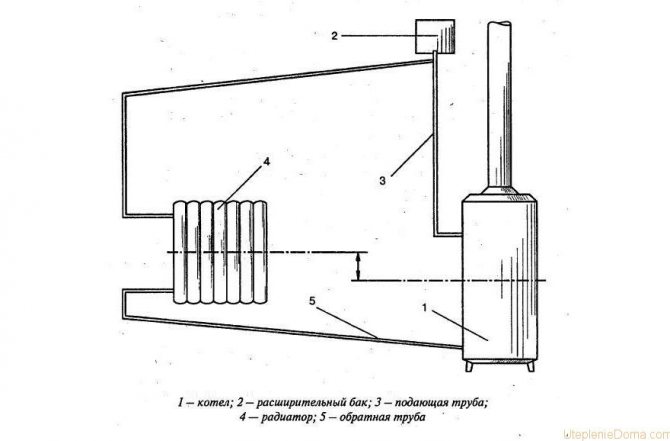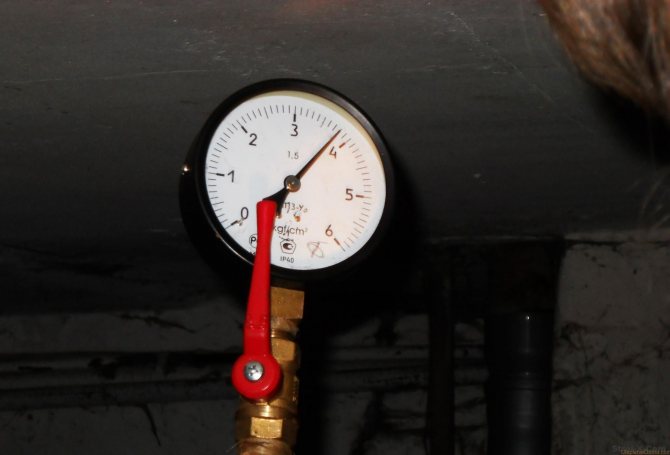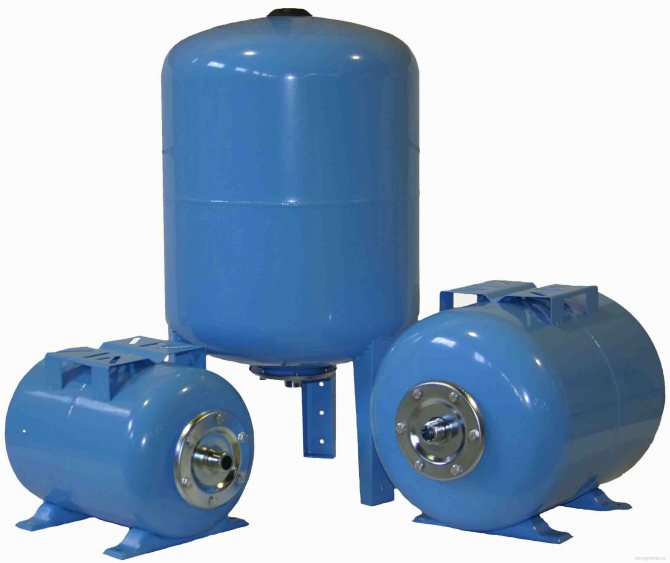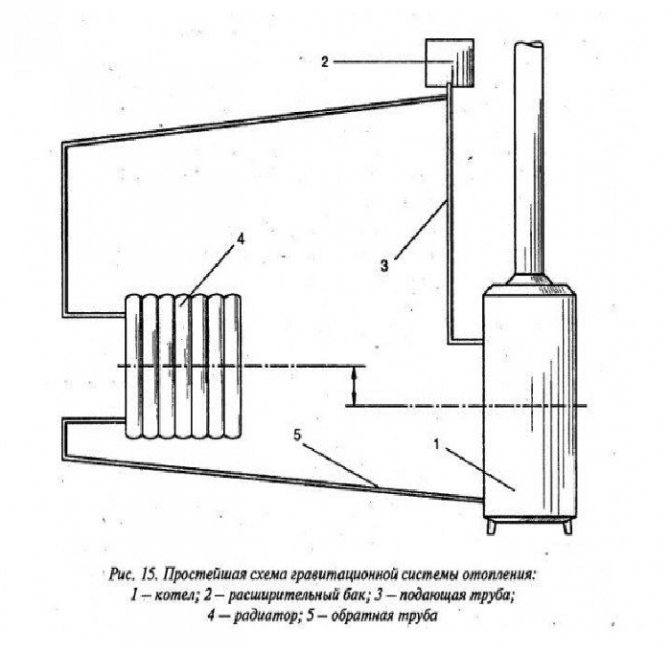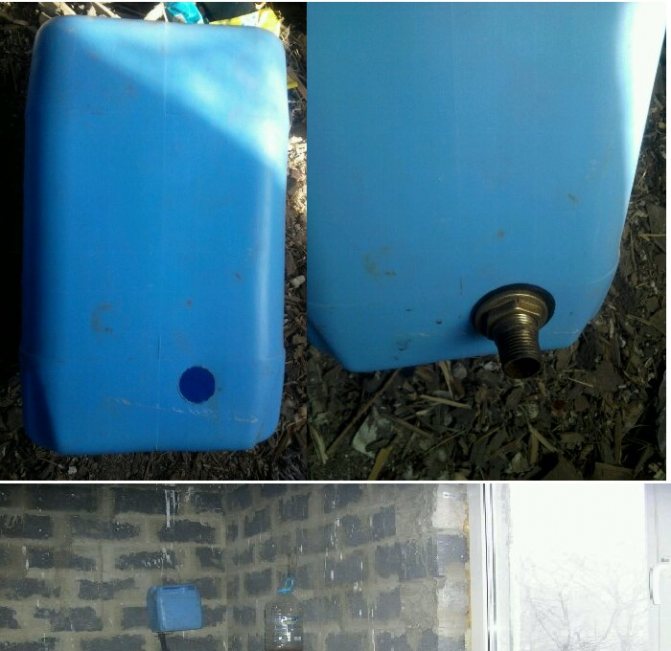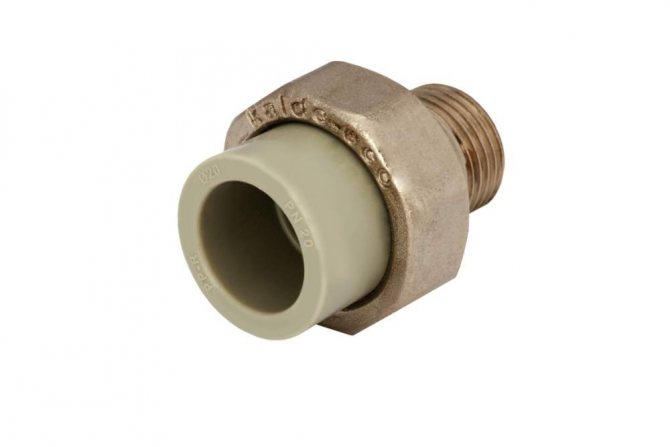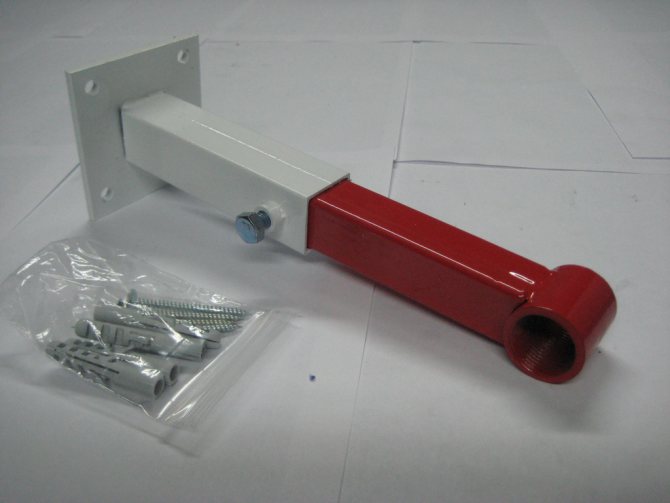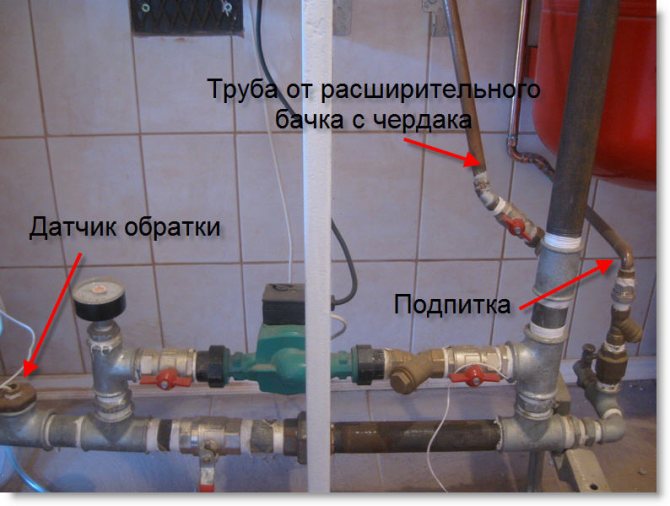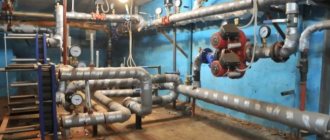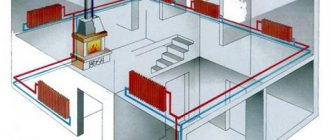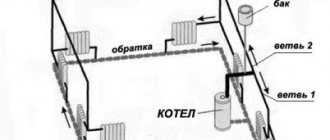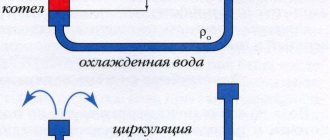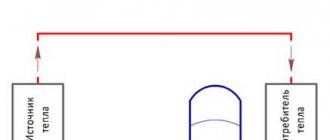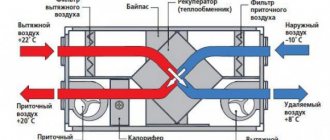Expansion tank calculation
To begin with, let's clarify the information a little: open-type expansion tanks (atmospheric) can also be installed on systems with forced circulation, this is the choice of the homeowner. We drew attention to this, since it is unlikely that it will be possible to make a closed-type membrane tank at home, but an open one is no problem.
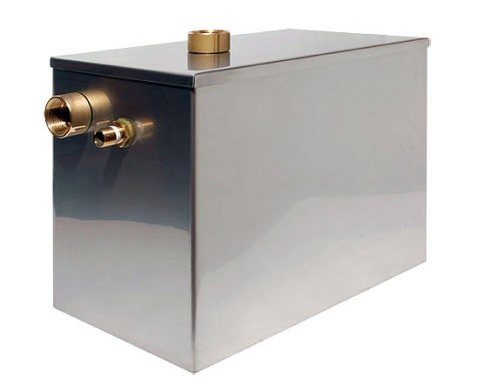
But first you need to understand what dimensions it will have, and for this to carry out the appropriate calculation. Without going into the jungle of formulas, we will apply the old proven method of determining the capacity of the tank. Knowing that when heated from 20 ºС to 80 ºС water adds approximately 4-5% in volume, let's calculate the amount of water in the system. In this case, one should take into account:
- the volume of the boiler tank - according to the manufacturer's technical documentation;
- capacity of radiators - according to the product passport;
- the amount of coolant in the pipes.
The calculation of the volume of water in the pipes is quite simple. The lengths of all lines and connections are measured with a distribution by diameter. Then the cross-sectional area of each pipe diameter is calculated and multiplied by its length. All the results are added up and the total amount of water is obtained, to which the volume of the coolant in the boiler and batteries is added.
Taking 5% of the total and adding another 5% of the stock, we determine that open-type expansion tanks should contain a tenth of what is in the system. Well, knowing the volume, it is easy to determine the size of the container.
Types and functions of expanders for heating
Gravity heating system with open expansion tank
Before considering expansion tanks for the heating system, you need to find out their purpose. It is associated with the property of water or a similar heat carrier to expand under the influence of temperature. As a result, the pressure in the system increases. Its excess must be compensated.
The use of an air vent or a similar shut-off valve is effective, but it has certain disadvantages. The main one is the exit of water from the system, as a result of which there is a high probability of the formation of air locks. But how does the expansion tank work in the heating system when overpressure occurs? Let's consider the general principle of operation using the example of the simplest open model:
- In the normal state, the closed expansion tank is 2/3 full;
- With an increase in the volume of the coolant, the filling level of the container increases, thereby stabilizing the system;
- As soon as the water temperature drops to the optimal level, its volume in the system will decrease to normal;
- At the same time, the level of the coolant in the tank stabilizes.
Closed models work the same way. The difference lies in the design - it is divided into 2 chambers. The first one is connected to the heating main and is filled with water, and the second one creates a pressure equal to the normal for this system. Moreover, both chambers are separated by an elastic membrane. As soon as the volume of the coolant in the pipes exceeds the critical one, the pressure in the expansion tank of the heating compensates for this process by displacing the membrane. In this way, the actual heating volume is temporarily increased.
An expansion tank is needed to compensate for the effect that an increase in the volume of the coolant has on the heating system during heating. An additional container connected to the circuit becomes a storage place for the resulting excess water. When the temperature drops, part of the coolant leaves the tank and returns to the pipes.
The process is repeated with each heating and cooling cycle. If there was no such reservoir in the system, then when the water was heated inside the pipes, the pressure would increase and then decrease.
Such fluctuations negatively affect the state of the system. They lead to leaks at the joints of devices and pipes and can even provoke equipment breakdown.
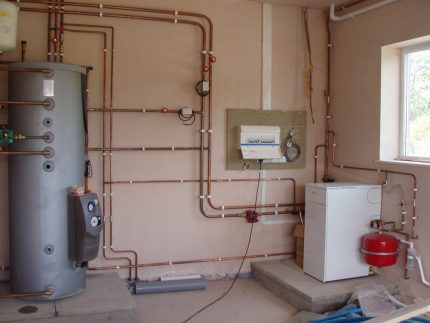

A membrane tank for heating is usually installed in a boiler room. A suitable location is on the return pipe between the pump and the heater
An expansion tank is selected depending on the characteristics of the heating system. For closed circuits, a special closed capsule with a membrane is needed, and for open circuits, a leaky container of a convenient configuration and of the required size is suitable.
A membrane tank should be selected that is designed to be in contact with hot water. Usually the body of such devices is painted red. A container for installation in an open circuit can be made independently, for example, welded from sheet metal. But it is important not only to choose the right device, but also to install it correctly.
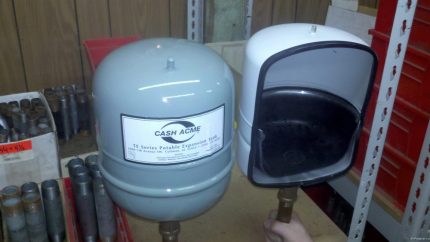

For closed heating systems, tanks with a membrane are used as an expansion tank, which allows you to store the coolant under a certain pressure
Tank design
The shape of the tank can be either round or rectangular, it doesn't really matter. It's just a little easier to make a rectangular tank. At the same time, with large volumes of liquid, a square tank will require reinforcement of the walls, which makes the entire structure heavier. But she must be taken to the attic. A round vessel can be made from a pipe, but it is more difficult to attach a lid to it, and its capacity will be less. It's up to you to choose.
Note. Often, homeowners, in order not to mess around for a long time, make an open-type expansion tank out of all kinds of plastic containers - buckets, cut off cans, and so on. But we need a solid metal tank, so we will not talk about canisters.
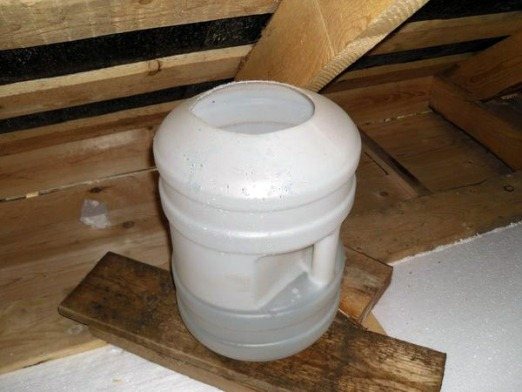

In general, the tank is a metal container with an open top, closed by a lid. Nozzles for connecting the heating system and the overflow hose are cut into the body of the product. There is also a more advanced design, where there are 4 nozzles, the functions of each of them are indicated in the diagram:
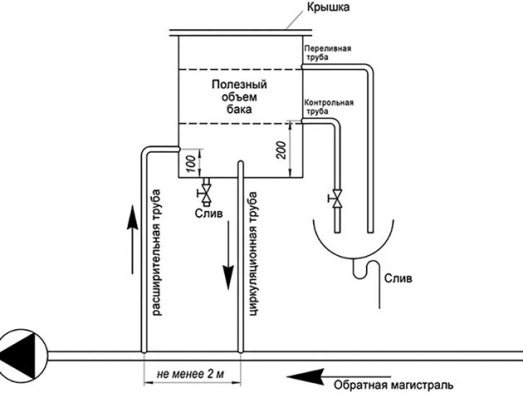

There is a supply and return branch connected to the return line so that the water does not stagnate, as well as a minimum level control pipe. The latter function is very convenient to use, you do not need to climb into the attic to make sure there is water. True, with this option, the installation becomes more complicated, you will have to lay additional pipes through the floors with your own hands.
Many homeowners get by with two pipes - for the coolant and the overflow. When water is added to the system, the tap is opened and the hose taken out into the street is monitored. The make-up valve is closed when water runs out of the hose, but then the tank is full to the brim and when heated, the coolant flows out of it for a long time through the overflow.
There is another design of a homemade container, although it can hardly be called open. The inner space of the tank is not in contact with the atmosphere and is only half filled with water. The rest is occupied by air, which plays the role of a damper during the expansion of the coolant. This heating tank has a pipe for replenishing water, draining and connecting to the piping network. The design is shown in the figure:
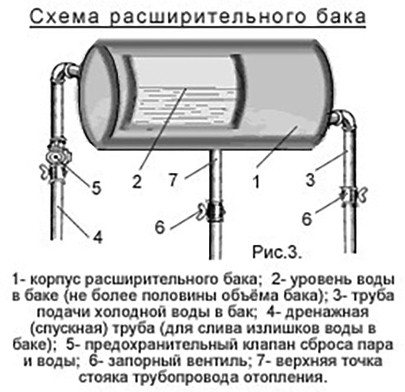

It is not worth making and using such a container, and here's why. When the system is operating, excess pressure will appear inside it, since there is no outlet for air, only an emergency valve. This means that under pressure, active diffusion of oxygen into the coolant will begin, which manufacturers of polymer pipes are constantly struggling with.Oxygenated water primarily destroys the steel parts of the boiler.
Place of installation
An expansion tank for closed-type heating is installed in a straight section in front of the circulation pump. Before, in the sense that the pump drives water from the expansion tank, and not into it. In this case, the expander works more correctly.
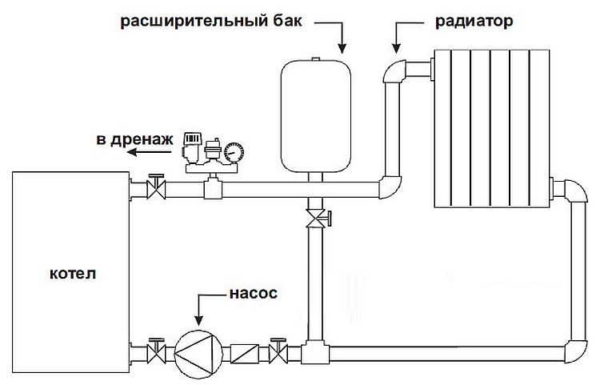

Installation space for diaphragm expansion vessel
To install a membrane tank, a tee is mounted, a pipe goes from it, to which the container is connected. The installation height does not matter. But it is better to put shut-off valves in front of and behind the tank. The membrane breaks down every few years. Even more often you have to check it, pump it up. So that for maintenance you do not have to stop and drain the system and put a shut-off valve. It is closed and the tank can be removed, checked, repaired.
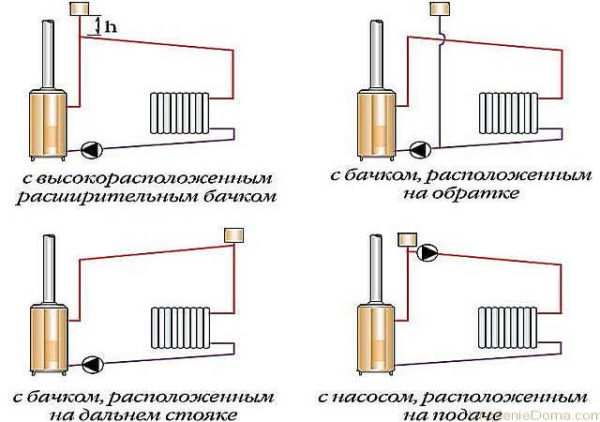

At the highest point
In open systems, the location of the expansion tank is selected based on other considerations. It is placed at the highest point of the system. In this case, it also works as an air collector. Air bubbles tend upward, and if there is an expansion tank at the highest point, they rise to the surface, leaving the atmosphere. So such a tank is deliberately made leaky so that air from the heating system can escape naturally.
The expansion tank compensates for the increase in the volume of the heated coolant, reducing the pressure in the wiring. Therefore, such a unit must be present in both open and closed heating systems. Moreover, a tank for a closed system can be made even with your own hands, using homemade or ready-made containers.
In most cases, the expansion joint for the heating medium is mounted between the pressure connection or the boiler branch pipe and the first battery. In this location, the open-type expansion tank replaces the safety valve - when the boiler overheats, steam will not go into the system, but will escape outward, directly into the atmosphere.
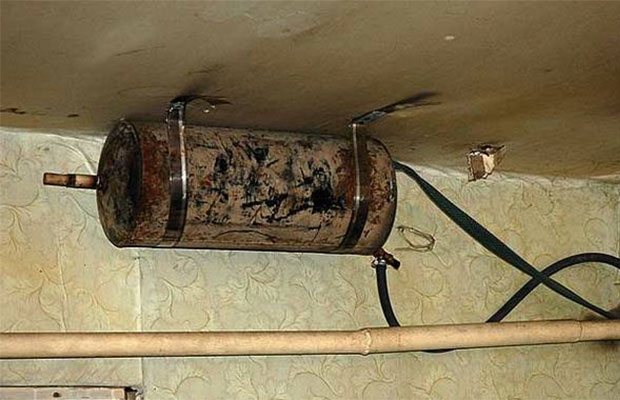

In multi-storey buildings, the expansion tank is mounted in the attic area or under the ceiling of the boiler room
Manufacturing and installation
To make the expansion tank of the heating system yourself, you need to have sheet metal, cut pipes of different diameters and a couple of corners in case you need to strengthen the wall or fix the container in place. From tools and devices you will need:
- welding machine;
- angle grinder;
- drill;
- a set of locksmith tools;
- tape measure, square.
Note. You can often hear advice that it is better to weld the container from stainless steel. Practical advice, it is relevant when the system is assembled from polymer or stainless steel pipes. If everything is made of metal, then there is nothing to worry about, you can cook from simple "black" steel.
Any home craftsman with welding skills knows how to weld a box. Then pipes are cut into the open expansion tank and sealed hermetically. The cover is made loose so that air can freely pass inside. When everything is ready, it remains only to check the welds for permeability and install the container in place, as shown in the diagram:
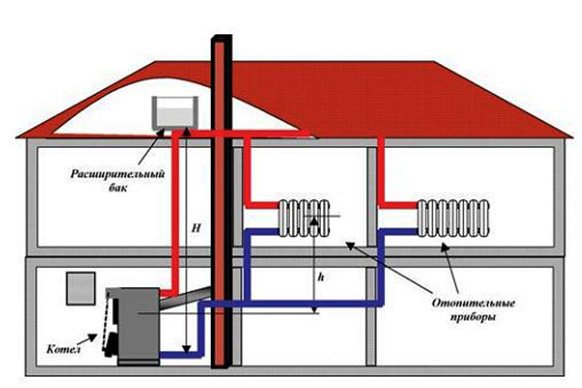

In order not to heat the attic space in vain, after installation, the tank body must be well insulated; for this purpose, mats or mineral wool slabs are suitable. Alternatively, you can glue the body with foam sheets. Some more skilled craftsmen automate the replenishment of the tank using a "toilet" float kit, but this is not a very reliable option. Remember how often the toilet is bubbling in your house and you will understand what it is about.
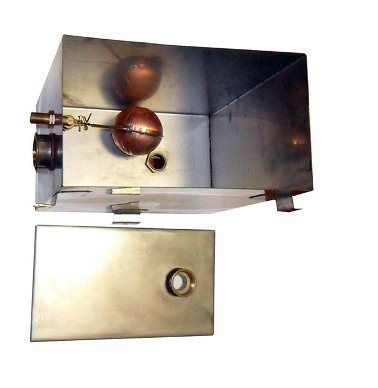

Open tank
Often, in large systems, closed-type tanks are mounted. The reservoir has a sealed body, inside of which there is a rubber membrane in the form of a partition.It regulates the pressure during the expansion of the liquid. For country houses, open tanks will be a suitable alternative. No special skills are required for their manufacture and installation. They are very easy to maintain and repair.
To ensure an uninterrupted supply of coolant, the device must perform the following functions:
- Regulate the pressure in the circuit. This is achieved by taking in excess hot coolant. Instead, cold liquid is supplied. As the temperature drops, the pressure in the system drops.
- Remove air. The tank is installed at the top point. The pipes are laid at a slight incline. All this provides an independent rise of air to the tank, where it is vented.
- The ability to restore the amount of coolant. During long-term operation of the system, the liquid evaporates. Thanks to the lid, which is installed on top of the tank, it is possible to freely restore the missing volume of liquid.
Due to such advantages and peculiarities of work, open tanks are very popular among specialists. They are often installed in heating systems in private houses.
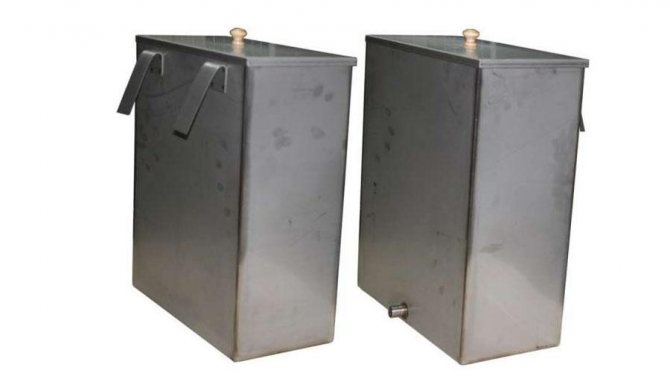

Open containers can be made by yourself
Principle of operation
The expansion tank works according to a fairly simple scheme. The whole principle can be divided into several simple steps:
- in a normal state, the tank is 70% filled with liquid;
- in the process of heating the coolant, the amount of liquid in the tank gradually increases to the maximum possible value;
- when the temperature drops, the liquid from the tank goes into the main pipe, and then to the heating devices;
- in parallel, the volume of the coolant stabilizes to the initial level (70%).
The operation of the device is controlled by special devices that are included in the design of the tank. Also, if necessary, you can check the correct functioning using the hole in the container lid.
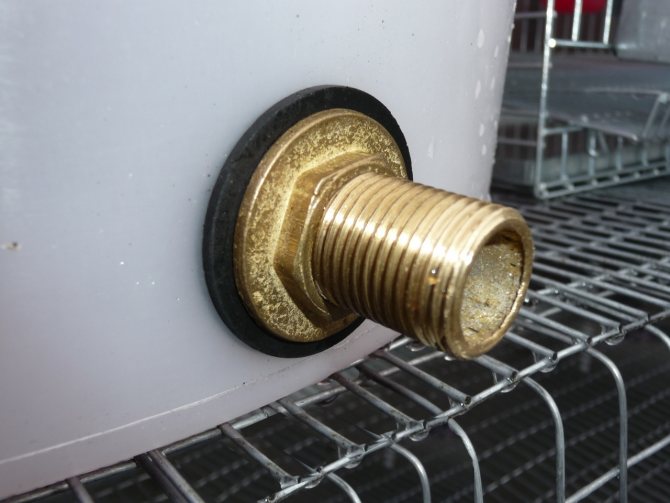

The arrangement of all pipes is important.
Design features
Today on the market there is a wide range of expansion tanks, which have different shapes, sizes and designs. As for the shape of the container, it can be round, cylindrical or rectangular. In all models, a cover is located on top, which allows you to monitor the fluid level and, if necessary, carry out its replenishment.
Often sheet steel is used for the manufacture of containers. Homemade tanks can be created from various materials, such as stainless steel and even plastic. Iron containers are covered with a special anti-corrosion layer. This protects them from corrosion and thus extends their service life.
Open tanks have several nozzles through which various pipes are connected:
- expansion - through it, the liquid lends itself to the tank;
- overflow - used to drain excess liquid;
- circulating - water is discharged to the heating system;
- control - used to remove air from the system and regulate the filling level of the pipeline.
There is also a spare hole for water discharge. This allows the container to be cleaned for repair work.
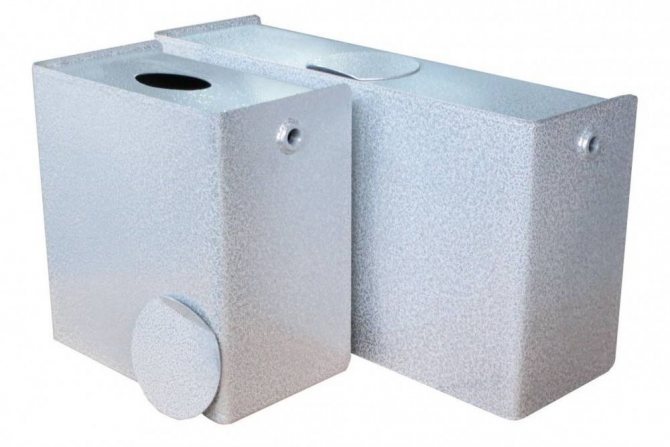

The tank must have the correct volume
Volume
When constructing heating and installing its individual elements, some factors must be taken into account. This also applies to the installation of an expansion tank. The volume of the container is of great importance here. The duration of the operation of the communication, as well as the functioning of its individual parts, depends on this parameter.
If you install a small tank, the relief valve will often operate. As a result, its service life will be significantly reduced. As for the large capacity, it is quite expensive. In addition, a lot of resources will go to heating a large volume of liquid.
Important! The system operation will be affected by the availability of free space inside the tank.
Appearance
The tank is a metal tank with an opening at the top that is covered with a lid. Topping up the missing amount of coolant is carried out through the upper part. The body is round or rectangular. The advantage of a rectangular tank lies in the simplicity and reliability of its fastening. Round containers have seamless walls, which ensures their tightness.
When constructing a hull, do not forget about reinforcement. This is especially true for large tanks. In order for structures to withstand a large volume of water, the walls must be strong and reliable. At the same time, this reinforcement will slightly increase the weight of the tank. This will significantly complicate its installation at the top point of the system.
Despite this, it is worth highlighting several advantages that homemade designs have:
- Standard and simple form. Everyone can build and install a rectangular tank. At the same time, there is no need to have special knowledge and skills.
- Simple construction. The tank is not equipped with special devices or elements. The uninterrupted operation of the equipment is controlled through an open hole.
- Minimum connections. Due to the minimum number of connections, the structure has high strength and reliability in operation.
- Low price. The construction of a rectangular building does not require a lot of time and money. Therefore, it is the most affordable option.
Before you mount a system element, it is worth considering that it has some disadvantages:
- unattractive appearance and inability to hide the tank behind a decorative finishing seam;
- rather low productivity;
- it is not possible to use other coolants, except for water, since antifreeze will quickly evaporate;
- the case is not sealed;
- due to evaporation during operation, it is necessary to periodically add water.
The air in the system is also important. Its presence leads to corrosion of the inner walls of pipelines, which reduces its service life. Also, the air in the system often becomes the cause of a decrease in heat transfer and the occurrence of noise during the circulation of the coolant.
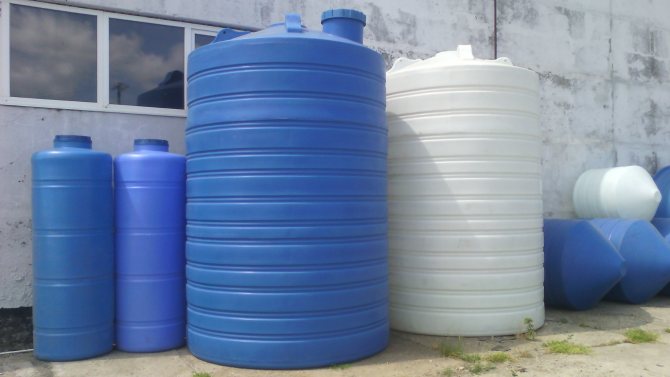

If desired, ready-made plastic tanks can be used for manufacturing
The purpose of the expansion tank
In fact, pipelines and heating devices change the internal volume filled with the coolant insignificantly when the temperature changes. As a coolant in heating systems, water is often used, which, when heated to a temperature 90-95 ° C can increase volume by 2.5-2.8%.
Attention! Excess liquid volume is directed into a special container, which is located above all in the heating system.
Another problem that is solved when installing an expansion tank is that the presence of such a capacity allows you to fill the system with a coolant.
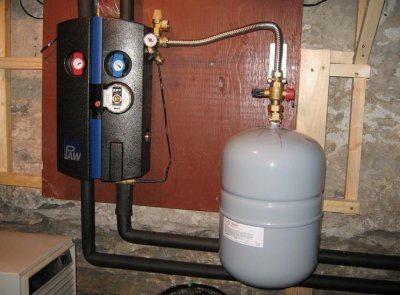

In order for the liquid flow to circulate through pipelines and heating devices, the condition of flow continuity (Daniel Bernoulli wrote about him in the middle of the 18th century).
Continuous flow - lack of places where there is no water. The presence of voids will create a condition under which the existing gas bubbles will not allow the fluid to move.
A similar phenomenon is observed in the initial period of the heating season, air lockswhich are removed by filling the system with water. Excess liquid is located on top in a special container.
Reference! Natural circulation inside an enclosed space is possible only if there is a certain hydrostatic head (Нst). The higher the Нst value, the more intense the circulation of the coolant.
With a decrease in the temperature of the coolant there is a decrease in volume... Part of the water from the expansion tank is returned to the heating system.
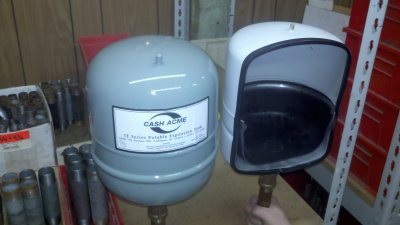

Heating systems perform with natural and forced circulation coolant.
Expansion tanks are used in traditional heating designs open type.
In cases where the coolant is prompted to move with the help of special circulation pumps, expansion devices are more often used. closed type.
Open type
The open-type expansion tank is a conventional metal box connected to the pipe from the heating main. It is posted in the highest available location buildings (houses).
During the heating season, the presence of water in the tank is regularly inspected. If necessary, add liquid to the expansion tank.
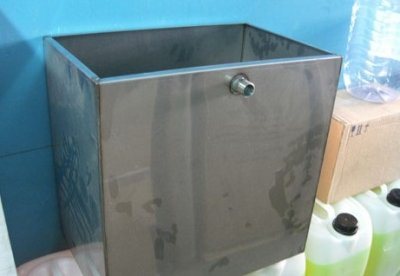

Some experts establish float system level control in the expansion tank. When the level drops, the float drops, which leads to the opening of the feed valve.
Water is topped up independently to the desired level. Automatic systems are installed only where there is a water supply system in which a pressure exceeding hydrostatic value Нst.
Pros of an open system:
- Extremely simple device, easy to make do it yourself.
- Can to function for yearswithout causing any complaints from users.
Disadvantages of an open system:
- Corrosion damages expansion tank first of all.
- Need to be monitored regularly presence of liquid and top up if necessary... Often, in private houses, when installing a heating system, the tanks for expanding the coolant are remembered last. I place it near the ceiling, which creates inconvenience when refilling. Forced to use flat bottlesto add water.
- It is necessary to lay additional pipe, which will only heat the space near the ceiling.
Important! The heating medium tends to evaporate. It needs to be refilled periodically so that the inside of the heating system does not form air locks.
Useful little things
We will allow ourselves to give some useful tips that may be useful to you when designing and self-installation of heating in your home.
- The volume of the expansion tank is taken equal to one tenth of the volume of the coolant in the heating system. If necessary, it is calculated more accurately, taking into account a rather long number of factors, but in practice there is no need for a PERFECTLY selected volume: it is chosen with a deliberate margin.
- Each membrane tank has a nipple through which it is easy to pump air to the excess pressure you need. From the factory, products come, as a rule, with an internal pressure of 1.5 kgf / cm2. The pressure in the heating system is typically 0.2 kgf / cm2 higher.
- On sale you can see red tanks for heating systems, and blue ones for water supply. The only difference between them is that in the second case, food grade rubber is used for the membrane.
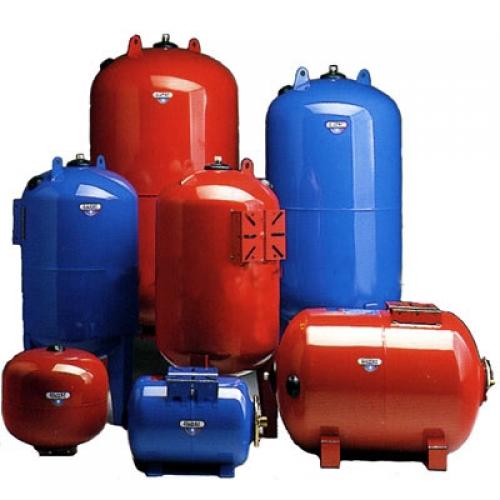

Both types of tanks can be used for heating. The fact that we see red more often is rather a tribute to tradition.
- During installation, it is better to orient the tank in space so that the coolant flows into it from above. In this case, there is guaranteed no air in the part of its volume intended for the liquid.
- Frequent operation of the safety valve means that you overshot to the smaller side with the volume of the tank. It is not at all necessary to dismantle it: it is enough to install one more device in parallel.
- An approximate calculation of the volume of the tank has already been written. It is taken equal to 1/10 of the volume of the coolant. If you do not know the exact volume, you can take 15 liters as a rough estimate for each kilowatt of boiler heat output.
- Modern electric boilers and gas fired with electric ignition often hide a circulation pump and an expansion tank in the housing, so make sure you need it before you go shopping.
Nuance: however, boilers with a capacity of over 30 kW are supplied without tanks. The reason is easy to guess: with a coolant volume of 30 * 15 = 450 liters, 1/10 of this volume will already be quite voluminous and will take up a significant part of the boiler body.
Useful information is contained in the article Electrode boilers - energy-saving heating boilers.
Making an expansion tank with your own hands: photo
You should start work by creating drawing or sketch future product. At the same time, materials and tools for the manufacture of an expansion tank available from a home craftsman are evaluated.
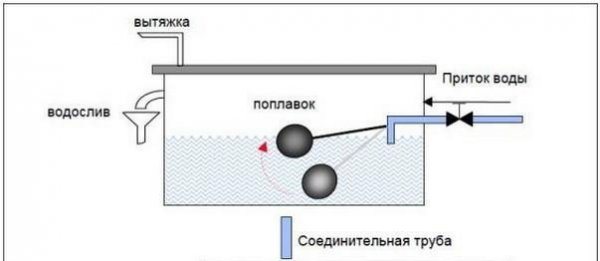

Photo 1. This is a diagram of an open expansion tank with a float water level control system.
The volume of the tank for the heating system of a separate house or apartment
Only during operation will it be noticeable how the coolant evaporates quickly. It will require frequent filling. It seems to many that a small volume is needed. There are recommendations that it is enough for the expansion tank to have capacity for 5-7 liters. Of course, such a volume is easier to find or manufacture.
When the boiler operating mode changes (even in winter there are thaws, when the heating medium is heated to the temperature of the entire 40-45 ° C). From the expansion tank, water can completely escape into the system.
Reference! In practice, it has been proven that the minimum necessary to have this container with a volume not less than 10% from the total volume of the entire system.
It is not difficult to calculate the volume of the expansion tank. The length of the pipelines is determined, as well as the number of sections in all batteries. For example, for a house with an area about 100 sq.m. the volume of the heating system is 120-140 liters. Then the expansion tank should be not less than 12-14 liters. You can use a little more to add water less often.
Direct manufacturing
When a home craftsman starts work, he has the following options:
- a ready-made container is used, such as a large saucepan, milk bottle or can for 12-15 liters or more;
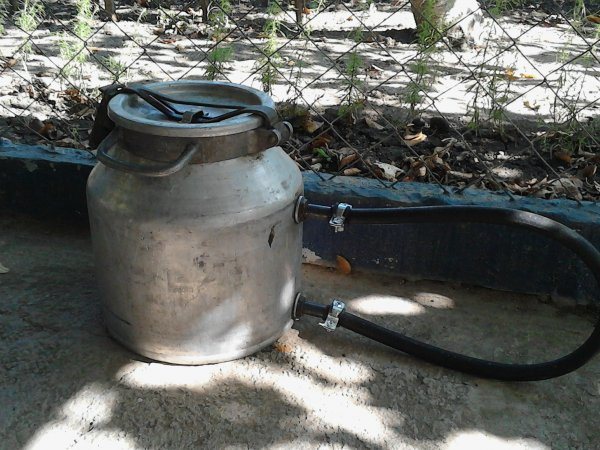

Photo 2. An expansion tank can be made from various containers, including a similar aluminum flask.
- available available sheet metal and welding machine.
How to properly make from a plastic canister
It's easier with ready-made containers. You need to have an electric drill with a set of drills. The process boils down to drilling a hole into which a pipe can be passed with a diameter of 21-27 mm.
- Find a drill so large diameter it can be difficult at home. Therefore, a circle is marked, and then holes are drilled along the contour.
- File with a file lintels and make the hole look acceptable.
- Use wide washers, rubber washers and nuts with the required pipe thread.
- Assemble the future design and set higher, preferably in the attic.
- To prevent intense evaporation cover with lids.
- To avoid freezing in winter they are additionally insulated... Use out-of-use warm clothes or various insulation materials, for example, "Ursa".
This method of manufacturing an expansion tank is the least expensive.
Important! If there is a milk flask available 40 l, then it is most convenient to use it to create an expansion tank for a heating system. The cover does not close tightly during operation, the rubber gasket is removed.
Manufacturing from sheet material
Certain requirements are imposed on the source material. The thickness of the sheets should be not less than 4 mm. When using a sheet with a lower thickness, the service life may be limited to only a few seasons.
How to make an expansion tank for heating with your own hands
It is very difficult to make a sealed tank at home. As experts say, it is better to pay and buy a quality item than to make it yourself.
But if you have a great desire, then you can make an expansion tank for the heating system with your own hands:
- first you need to make a body or frame. It must be made of 2 metal parts;
- a flange must be attached to each part in order to screw the membranes and connect both halves;
- it will turn out 2 chambers inside - air will enter into one, and liquid will accumulate in the other. Both halves should not be interconnected, otherwise nothing will work;
- in one of the parts, you need to insert a pipe so that excess liquid flows, and in the second part, insert a nipple in order to regulate the amount of free air in the system (to bleed air);
- the body must be metal, but the membrane must be rubber. It must be installed between the two halves of the chamber, the flange must be bolted together. We remind you once again that absolute tightness must be observed;
- it remains to install the tank in place, connect it to the heating system and check the operation in action;
- and it is also very important - the pressure in the tank must be adjusted individually, according to the parameters of the boiler.
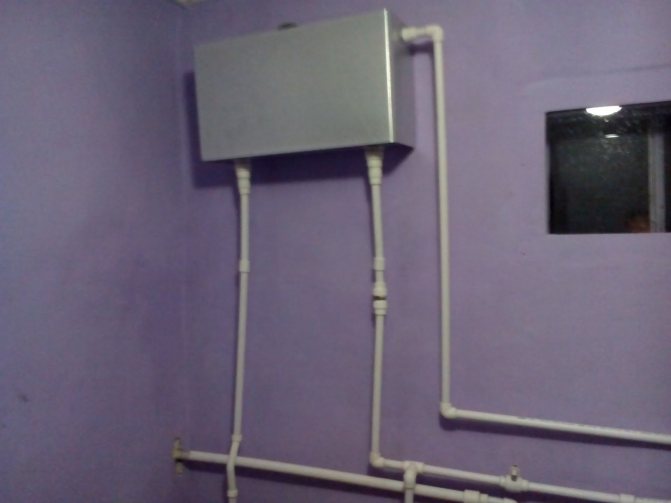

Summary
The expansion tank is the most important device in the heating system, which ensures operability during the entire heating period. The simplest tanks can be made home craftsmen on their own. In case of difficulty, it would be better to contact to specialists.
At the weekend, I redid the heating, took out the expansion tank to the attic. The old one was made of a plastic canister into which a special brass adapter was screwed so that the pipe could be connected, I do not know what it is called correctly, to screw the brass adapter into the canister I had to cut such a hole (see photo below), at first the heating was imperfect and a few since my system boiled, so the canister from under the primer led a little, this is clearly noticeable, but nevertheless for two winters the canister served faithfully as an expansion tank.
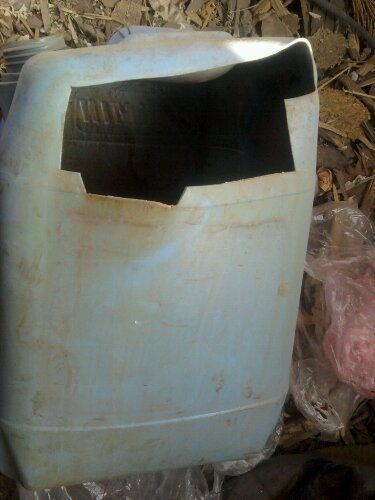

This canister hung in an unfinished room and embarrassed me, I had long wanted to take it to the attic, and suddenly I came up with a way to make a hole in the canister and attach a brass fitting without cutting a huge hole for the hand to insert from the inside. We take a canister from under the primer, I took it for 10 liters, my heating will be enough with a margin:
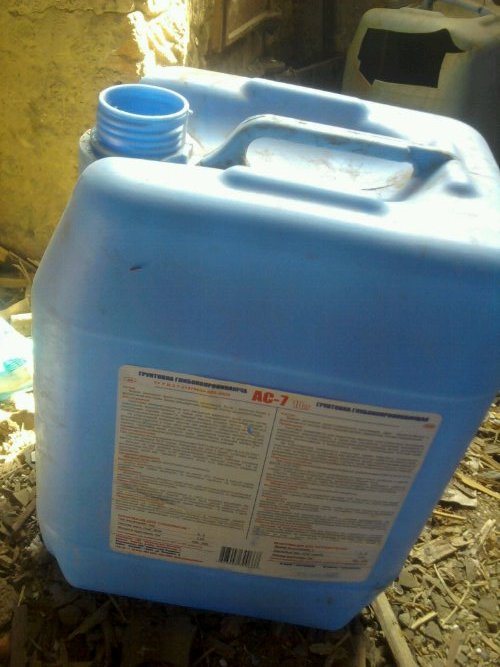

We make a hole in the right place, I made it just above the bottom, so that if suddenly some kind of debris gets into the heating system and just settles to the bottom. The hole is easily made with a clerical knife, I periodically check whether the fitting fits, cut off the excess.
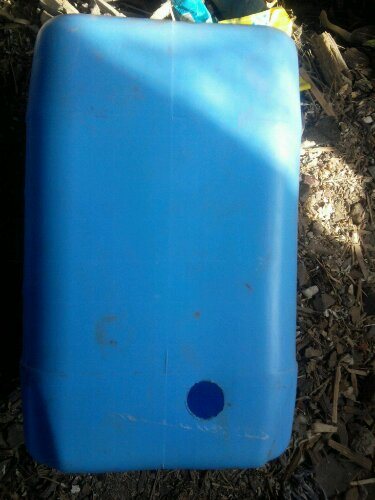

Now there are two holes in the canister, one regular and the second made by me, we push into both a piece of wire, and the fitting slides along it directly to the hole made
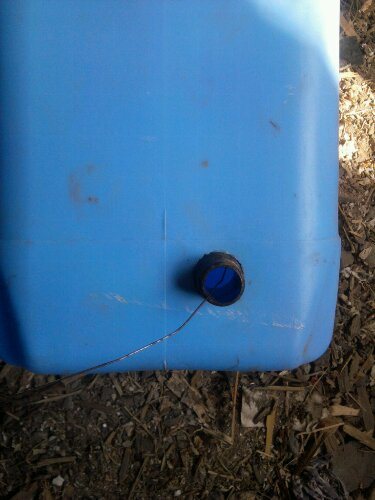

I push the fitting into the hole, put on a rubber gasket
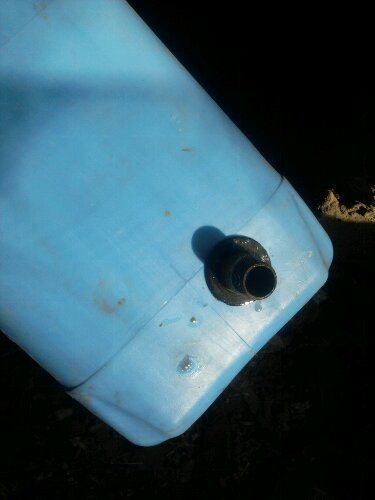

I put on the nut and tighten, the expansion tank is ready
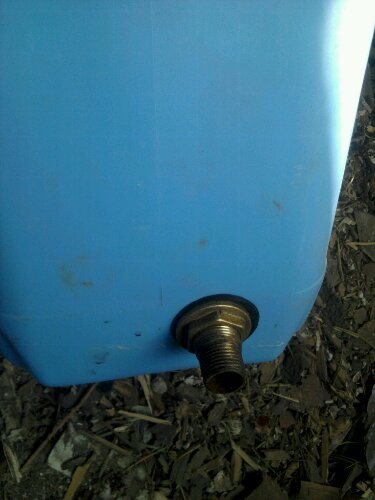

My tank with heating is connected with a piece of rubber hoses with clamps, but you can solder an American woman to a plastic pipe and connect it more thoroughly, but as my two-year experience has shown, it is already quite reliable.
Calculating the physical dimensions of the device
A hydraulic accumulator of this type is installed where there is a minimum probability of turbulence of the coolant, since a pump is used for normal circulation of the water flow along the circuit.
When connecting the expansion tank to a closed heating system, it is imperative to take into account the location of the air chamber of the device.
The rubber membrane is periodically stretched and then contracted. Due to this effect, over time, microcracks appear on it, which gradually increase.After that, the membrane has to be replaced with a new one.
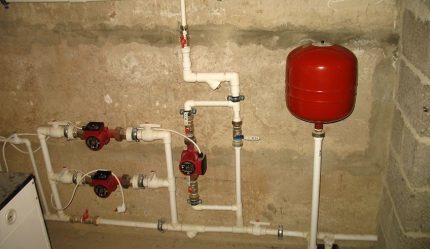

It is better to install an expansion tank with a membrane so that the compartment filled with air is on top, this will extend the life of the device
If the air chamber of such a tank remains at the bottom during installation, then the pressure on the membrane will increase due to gravitational action. Cracks will appear faster, repairs will be needed earlier.
It is wiser to install the expansion tank in such a way that the compartment filled with air remains on top. This will extend the life of the device.
There are a number of requirements to consider when installing a diaphragm expansion vessel:
- It cannot be placed close to the wall.
- Ensure free access to the device for regular maintenance and necessary repairs.
- A tank suspended on the wall should not be too high.
- A shut-off valve should be installed between the tank and the heating pipes, which will allow you to remove the device without completely draining the coolant from the system.
- The pipes leading to the expansion tank must also be attached to the wall in case of wall installation in order to remove any additional load from the tank nozzle.
For a membrane device, the most suitable connection point is the reverse section of the line between the circulation pump and the boiler. Theoretically, it is possible to put an expansion tank on the supply pipe, but a high water temperature will negatively affect the integrity of the membrane and its service life.
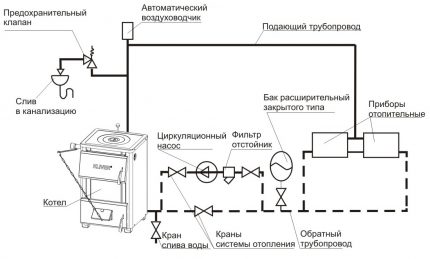

When installing the expansion tank, it is necessary to provide shut-off valves that will disconnect the device from the system and drain water from it.
When using solid fuel equipment, such an arrangement is also dangerous because steam can enter the container due to overheating. This will seriously disrupt the operation of the membrane and may even damage it.
In addition to the shut-off valve and the "American", it is recommended to install an additional tee and a tap when connecting, which will allow the expansion tank to be emptied before disconnecting.
Before or immediately after installation, it is necessary to correctly adjust the expansion tank, otherwise called the expansomat. This is not difficult to do, but first you need to find out how much pressure should be in the heating system. Let's say the acceptable figure is 1.5 bar.
Now you need to measure the pressure inside the air part of the diaphragm tank. It should be less by about 0.2-0.3 bar. Measurements are carried out with a pressure gauge with a suitable graduation through the nipple connection, which is located on the tank body. If necessary, air is pumped into the compartment or its excess is vented.
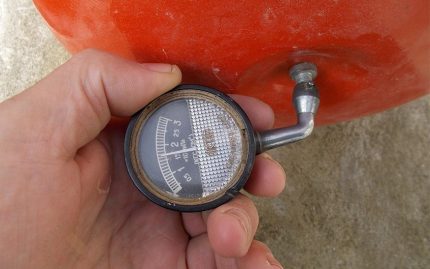

Before installing the membrane tank in the heating system, check the air pressure in the air compartment and adjust it in accordance with the requirements
The technical documentation usually indicates the working pressure, which is set by the manufacturer at the factory. But practice shows that this does not always correspond to reality. During storage and transportation, some of the air could escape from the compartment. It is imperative to take your own measurements.
If the pressure in the tank is set incorrectly, this can lead to air leaks through the device for its removal. This phenomenon causes a gradual cooling of the coolant in the tank. It is not necessary to pre-fill the membrane tank with a coolant; it is enough to simply fill the system.
Modern models of heating boilers are often already equipped with a built-in expansion tank. However, its characteristics do not always correspond to the requirements of a particular heating system. If the built-in tank is too small, an additional tank must be installed.
We suggest that you familiarize yourself with How to make moonshine at home in 5 steps, simple instructions, recipe
It will ensure the normal pressure of the coolant in the system.This addition will also be relevant if the heating circuit configuration is changed. For example, when a gravity system is converted into a circulation pump and old pipes are left.
This is also true for any systems with a significant volume of coolant, for example, in a two-three-story cottage or where, in addition to radiators, there is a warm floor. If a boiler with a small built-in membrane tank is used, the installation of another tank is almost inevitable.
The expansion tank will also be appropriate when using an indirect heating boiler. A dump valve, similar to that installed on electric boilers, will not be effective here, an expanzomat is an adequate way out.
In order for the expansion tank of the heating system to correctly perform the tasks assigned to it, the owner must make sure that this element meets the design parameters. The calculation of the tank can be done with the involvement of heating specialists who will take into account all the operating parameters of the system and provide their verdict as to which expansion tank is needed to heat a particular building. But the homeowner can make the necessary calculations on his own.
To find out which expansion tank for heating should be installed in the system, the owner must have information regarding the following parameters:
- the total volume of water in the circuit;
- nominal pressure;
- range of temperature regimes of the circuit.
Next, you should calculate the volume that water creates when heated. This can be done based on the following information - when heated from 20 to 80 degrees, the coolant expands by 5%. In addition to this five percent, another five percent is added for the stock.
Knowing how much of the expansion tank is needed for heating, the owner can easily determine its physical dimensions.
Expansion vessel filling factors
Before installing an expansion tank with a membrane in the heating system, you need to calculate its volume. A simple scheme for an open container is not suitable in this case. To do this, you need to use a different technique.
Where E is the coefficient of thermal expansion, C is the total volume of the coolant in the system, Pmin is the initial pressure in the system, Pmax is the maximum allowable pressure value, Kzap is the filling factor of the tank at various pressures. The data is taken from the table.
Pressure readings must be accurate. Otherwise, regardless of the location of the expansion tank in the heating system, it will not perform its functions or will quickly fail. It is recommended to add 5% for the stock to the resulting calculated indicators. It may be required when installing additional sections of radiators in the system and increasing the total volume of the coolant.

